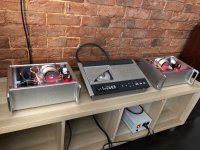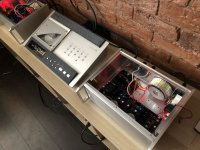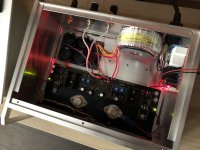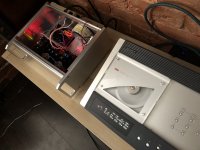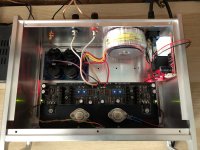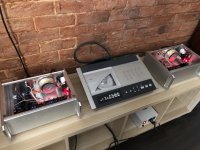Hi! How hot does your front panel get? Can you hold your hand on it for at least 3 seconds after it’s been running for an hour or so, with the tops installed on each?
Last edited:
Hi! How hot does your front panel get? Can you hold your hand on it for at least 3 seconds after it’s been running for an hour or so, with the tops installed on each?
that's not that hot really, since its almost 15mm thick, then 10mm side panels also dissipating. I also put 75'C thermal switch right on VFETs, just for a case, its a part of "start delay" board (visible on the right side panel with red led on it).
Last edited:
without air flowing through case ( no holes on bottom and top ) , you'll have dead caps in a year
without air flowing through case ( no holes on bottom and top ) , you'll have dead caps in a year
its actually Epcos 105c, very rugged. However, no problem to drill the holes =))
if holes solution is going to end messy - put spacers on bolts holding bottom and top , to have lids with slit on circumference
plenty of air that way , with 5mm slit
plenty of air that way , with 5mm slit
if holes solution is going to end messy - put spacers on bolts holding bottom and top , to have lids with slit on circumference
plenty of air that way , with 5mm slit
yep, nice idea, thanks.
or cut sort of windows and bolt nice mesh to fill it
nicer than holes , except if you can do it on CNC , making nice slots
nicer than holes , except if you can do it on CNC , making nice slots
Have you had it running for over an hour with the lid on? Have you tested the thermal switch? 🙂
Have you had it running for over an hour with the lid on? Have you tested the thermal switch? 🙂
yep, tested thermal switch separately, and its confirmed working. Now the amps running for almost 3 hours with no lids.
or cut sort of windows and bolt nice mesh to fill it
nicer than holes , except if you can do it on CNC , making nice slots
that's was my first thought - I have some perforated metal sheet for speaker drivers protection... thought to cut the window on bottom and top lids, like it was styled back in seventies for tube devices... or just to make the whole lids from this perforated sheet.
yep, tested thermal switch separately, and its confirmed working. Now the amps running for almost 3 hours with no lids.
When you run the amps with the lids on, even after adding ventilation openings top and bottom, the front end transistors and VFETs will run hotter and all the pots will require tweaking to get the biasing and offsets correct again.
Last edited:
When you run the amps with the lids on, even after adding ventilation openings top and bottom, the front end transistors and VFETs will run hotter and all the pots will require tweaking to get the biasing and offsets correct again.
thanks, I will arrange an access to the pots even with top lids closed.
no need for that ..... all you need is set of crocs with wires for DVM probes , lid closed up to temp equilibrium , then reasonably fast process of opening lid - readjusting in half step , then closing the lid .....
Ok, now its several days they both works fine. And yes, they are REALLY hot, so after an hour it is not possible to hold the hand on front panel (which is the heatsink). Output devices measured 63C max with top lids closed, no ventilation. I believe 105C caps will last much longer then couple of years. What to say more: sound is ... special, now I can not say I like it or not. The only word spinning in my head regarding the sound is: clear, clarity, clarification, clearness. Timbres are somewhat subtile, to my perception. Low-end highs are almost absent, alas voice and mid-range are emphasised. Bass is deep, but not that solid, like in good powerful mosfet amp... maybe the source is not that good or they need more time to burn-in. Nevertheless it was a good exciting adventure.
Nice work 🙂
I wish I had a couple of VFET to make an liquid cooled VFET amplifier 😀
but they are almost unobtainable 😕
.
I wish I had a couple of VFET to make an liquid cooled VFET amplifier 😀
but they are almost unobtainable 😕
.
Nice work 🙂
I wish I had a couple of VFET to make an liquid cooled VFET amplifier 😀
but they are almost unobtainable 😕
.
PM me, I have two pairs of sk76/sj26. Not precisely matched by Vgs, but this is OK for this particular project, since each VFET is biased separately.
Anyone with at least two unmatched VFETs of either polarity will be able to
build something of interest, no problem. The only limitation will be power.
Anyways, be patient and no one will go hungry.
😎
I found this out 😀
what will be the power limitation , in the sk76/sj26 unmatched case ?
.
- Home
- Amplifiers
- Pass Labs
- Sony vFET Amplifier Part 2

